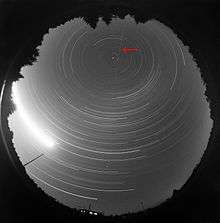Definify.com
Definition 2025
Earth-grazing
Earth-grazing
English

The Earth-grazing meteoroid EN131090 that briefly entered the Earth's atmosphere on 13 October 1990, photographed using an all-sky camera from Červená Hora, Czechoslovakia (now in the Czech Republic). The red arrow indicates the meteoroid's path from south to north, which appears as a faint line. The bright light track on the left is the Moon.
Adjective
Earth-grazing (not comparable)
- (astronomy) Of a meteoroid: entering the Earth's atmosphere and leaving into space again.
- 1991 August, D. W. Olson; R. L. Doescher; K. M. Watson, “Computer Simulation of Earth-grazing Fireballs”, in WGN, volume 19, number 4, Mechelen, Belgium: International Meteor Organization, OCLC 926210703, pages 130–131:
- A computer program especially suited to the simulation of Earth-grazing meteors has been listed and described in the Astronomical Computing department of Sky & Telescope. The program allows for the curvature of the Earth; it is therefore possible to follow an Earth-grazing meteor as it descends, reaches perigee, and then ascends back into space.
- 2012, Z. Ceplecha, “Commission 22: Meteors & Interplanetary Dust/Météores & Poussière Interplanétaire: Photographic Meteors, Fireballs and Spectroscopy”, in Jacqueline Bergeron, editor, Reports on Astronomy (Transactions of the International Astronomical Union; XXIIA), Springer Science+Business Media, DOI:, ISBN 978-94-010-4481-3, page 212:
- Data on an Earth-grazing fireball photographed in 1990 October were published by Borovička and Ceplecha (1992). The U.S. daylight Earth-grazing fireball from 1972 is continuously referred to with much greater mass than the observations indicate (Z. Ceplecha 1993, submitted to Astron. Astrophys.).
-
- (astronomy) Approaching the Earth closely.
- 1986, Julian Schwinger, Einstein's Legacy: The Unity of Space and Time (Scientific American Library Series; 16), New York, N.Y.: Scientific American Library, ISBN 978-0-7167-5011-6, page 219:
- How many [orbital periods] are there in a year for an Earth-grazing satellite? Since the time of Sputnik (October 4, 1957), it has been familiar that a satellite in a low orbit revolves about the Earth in about 90 minutes. That period would be 84 minutes for the hypothetical Earth-grazing satellite.
- 1991 January 27, Blaine P. Friedlander Jr., “Asteroid hurtled near Earth Jan. 18”, in The Washington Post:
- The closest previous sighting of an Earth-grazing asteroid was in March of 1989. It was 330 feet in diameter and passed at 10 times the distance to the moon.
- 2000, Fred W. Price, The Planet Observer's Handbook, 2nd edition, Cambridge: Cambridge University Press, ISBN 978-0-521-78981-3, page 192:
- The ‘Earth grazing’ asteroid Hermes was photographically discovered by [Karl Wilhelm] Reinmuth on October 28th 1937. It came to within nearly 500 000 miles (800 000 km) of the Earth which is less than double the distance that separates the Earth from the moon. On October 30th 1937 Hermes, which was of the 8th magnitude, sped path the Earth at an angular pace in the sky of 5° per hour, so fast that its distance could not be deduced by using the usual mathematical methods. Instead it had to be calculated from its parallax as seen from two different observatories. It was ‘lost’ in 1937.
-
Translations
entering and leaving the Earth's atmosphere
|